Air Pollution and Autism

Understanding the Environment's Role in Autism
Recent scientific research increasingly suggests that environmental factors, particularly air pollution, play a significant role in the development of autism spectrum disorder (ASD). Exposure to various pollutants during sensitive developmental periods such as pregnancy and early childhood has been linked to neurodevelopmental changes that may increase ASD risk. This article explores the mechanisms, evidence, and implications of this emerging area of study, aiming to deepen understanding and highlight potential avenues for intervention.
The Genetic and Environmental Foundations of Autism
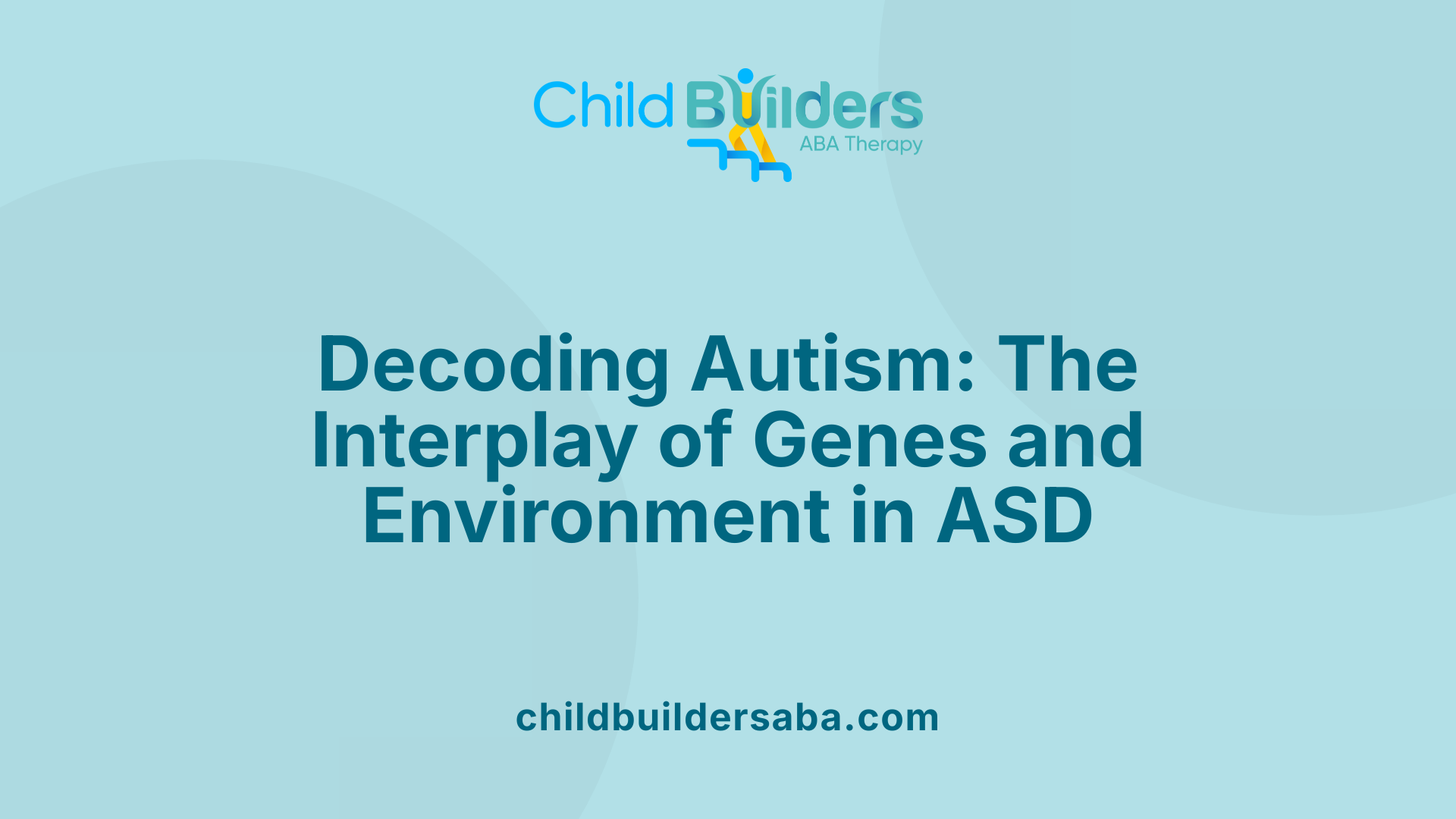
What is the estimated genetic contribution to autism spectrum disorder?
The heritability of autism spectrum disorder (ASD) is believed to be around 83%, according to recent detailed analyses of large Swedish twin and family datasets. This figure aligns closely with earlier twin studies, which estimated heritability to be approximately 90%. These estimates indicate that genetics play a dominant role in the development of ASD.
Most of the genetic risk involves inherited gene variants, de novo mutations, and alterations affecting genes responsible for brain development, neural connectivity, and synaptic functioning. While environmental factors, such as air pollution, can influence ASD risk—especially during critical developmental windows—they account for a smaller proportion of the variance.
Research shows that shared environmental influences have a minimal impact, emphasizing that ASD is primarily driven by genetic predisposition. However, environmental exposures may interact with genetic vulnerabilities to increase the likelihood of ASD in susceptible individuals.
Overall, it is clear that genetics form the core basis of ASD, with environmental factors like air pollution acting as potential triggers or modifiers rather than primary causes. This understanding helps in framing both preventive strategies and research directions, highlighting the importance of considering both inherited and environmental influences in autism.
Air Pollution as a Modifiable Risk Factor for ASD
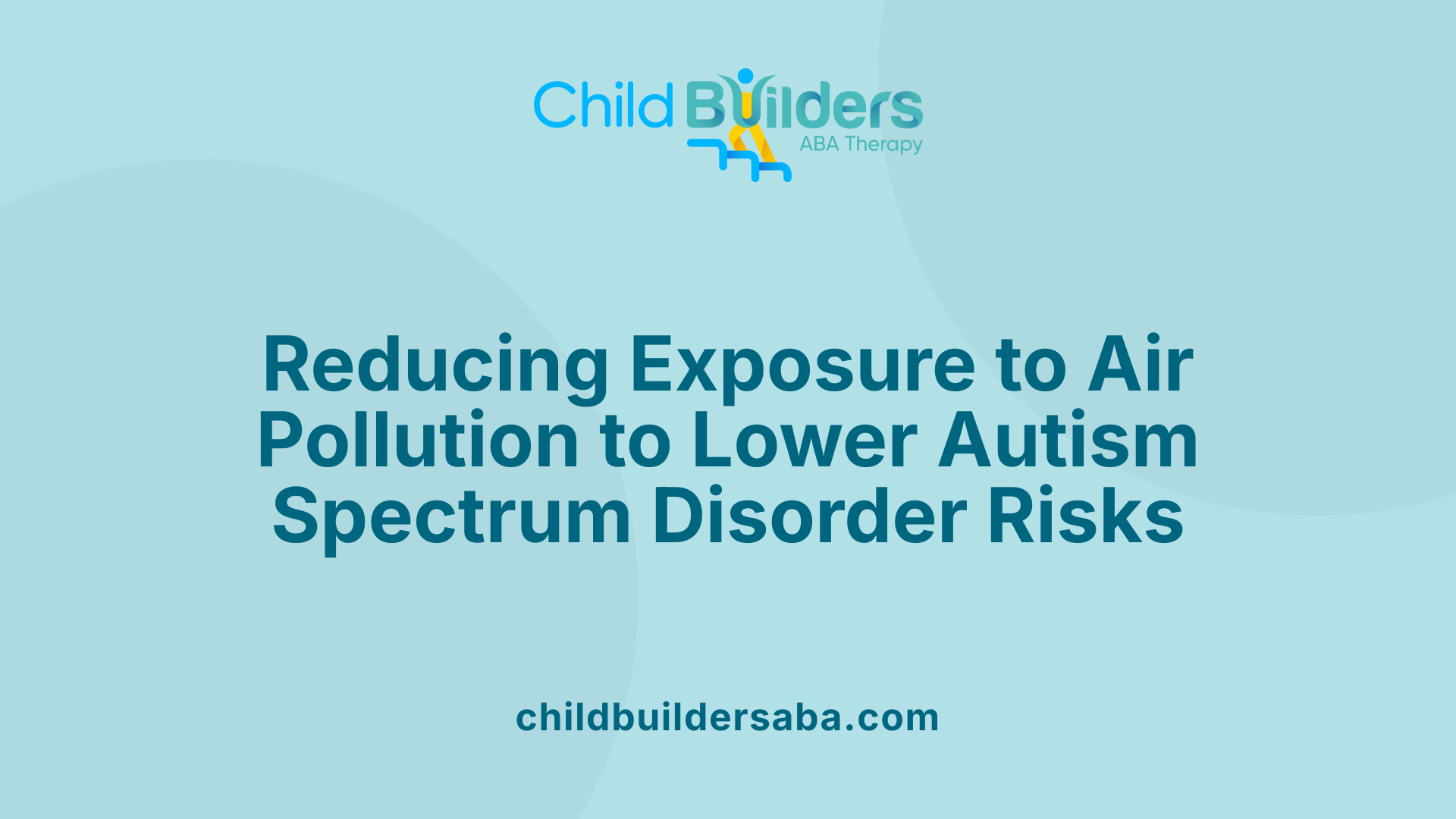
Are there environmental risk factors, like air pollution, associated with autism?
Yes, extensive research indicates that environmental factors, particularly certain pollutants, are linked to an increased risk of autism spectrum disorder (ASD). Numerous studies have identified prenatal and early-life exposure to air pollution—such as fine particulate matter (PM2.5), nitrogen oxides (NO and NO₂), ozone (O₃), sulfur dioxide (SO₂), and volatile organic compounds—as factors that may influence neurodevelopment.
A comprehensive meta-analysis published in April 2021 in Environmental Research Letters confirmed associations between exposure to PM2.5 during pregnancy and early childhood and the increased risk of ASD. Specifically, the risk rises by approximately 31% during prenatal exposure, with the highest vulnerability during the third trimester. Postnatally, early childhood exposure to PM2.5 correlates with a 64% increased risk.
Environmental studies also point to sources like traffic emissions, industrial pollution, residential wood burning, and wildfires as significant contributors. For example, a cohort study from Sweden involving over 40,000 children found that exposure to PM2.5 from multiple sources during pregnancy was linked to roughly 20-30% higher odds of childhood autism. Similarly, research from China demonstrated that children exposed to PM2.5 from vehicle exhaust and industrial emissions had up to a 78% increased risk of developing ASD.
The biological mechanisms are believed to involve neuroinflammation, oxidative stress, disruption of neurotransmitter systems, and epigenetic modifications that can alter fetal brain development. These pollutants can cross the placental barrier, reaching the fetal brain and interfering with crucial neurodevelopmental processes.
Furthermore, studies accounting for confounders like socioeconomic status and parental age have reinforced the robustness of these associations, suggesting that air pollution is a potentially modifiable environmental risk factor. Experts agree that minimizing exposure during critical windows of development could help lower ASD risk, emphasizing prenatal and early childhood periods as particularly sensitive.
Overall, while more research is needed to establish causality, the accumulating evidence supports the need for public health measures to reduce air pollution exposure, especially for pregnant women and young children, to help reduce ASD risk.
Impact of Specific Air Pollutants on Autism Risk
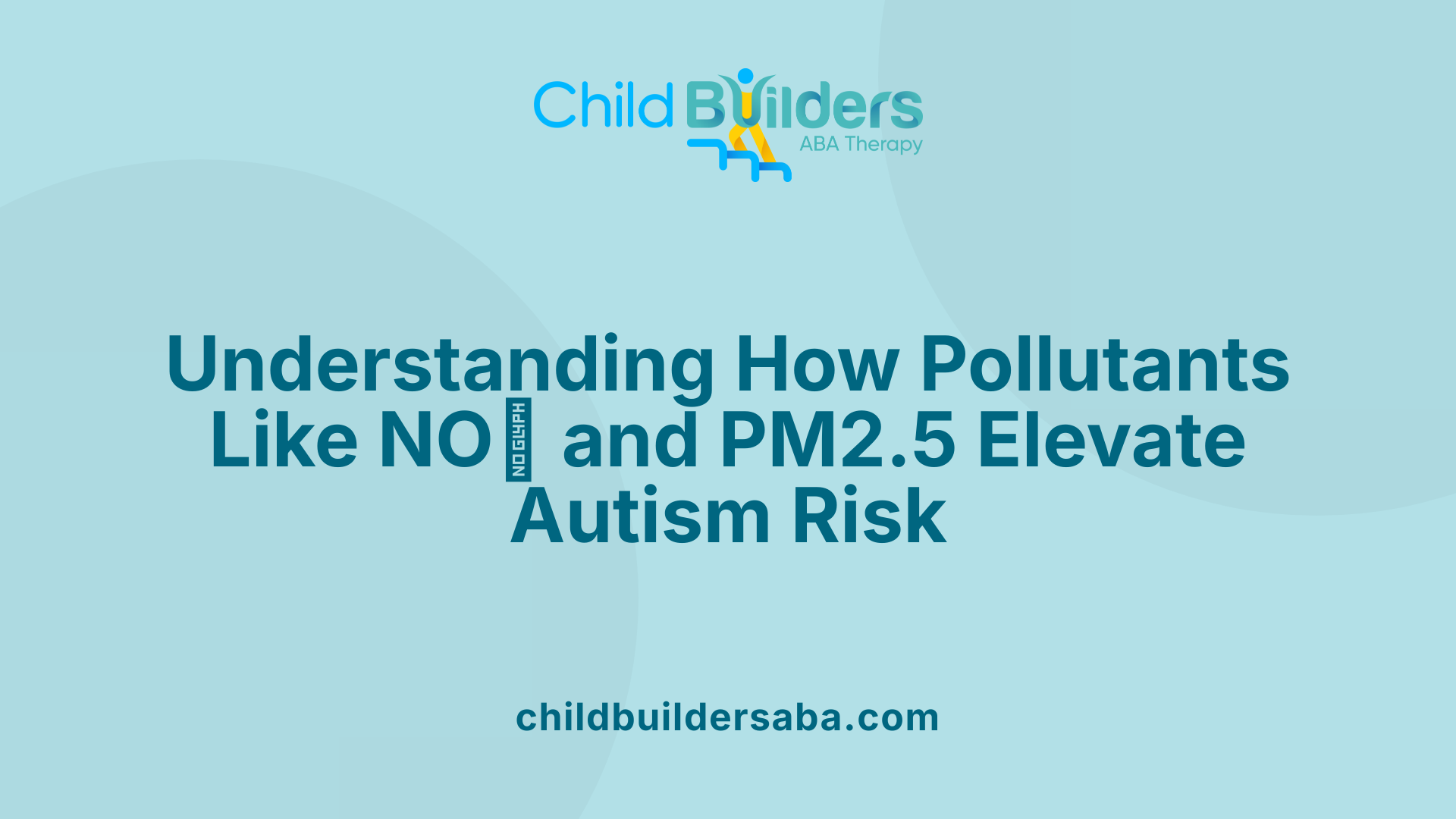
How does exposure to specific air pollutants, such as nitrogen dioxide and particulate matter, influence autism risk?
Research consistently shows that exposure to certain air pollutants during pregnancy and early childhood can increase the likelihood of developing autism spectrum disorder (ASD). Notably, nitrogen dioxide (NO2) and fine particulate matter (PM2.5) are closely linked to higher risks.
Children living in areas with elevated traffic-related air pollution (TRP) during critical growth periods are more prone to ASD. Some studies report that the odds of autism double or even triple in children exposed to high levels of these pollutants during certain developmental windows. For example, a nationwide study in Denmark found that exposure during early life was associated with increased autism diagnoses, with odds ratios around 1.8 for NO2 and PM2.5.
Regional air quality data also support these findings. Increases in nitrogen dioxide, PM2.5, and larger particles like PM10 during pregnancy and the first postnatal year are linked with a significant rise in autism cases. Some research indicates that each incremental rise in pollutant levels correlates with a 20-40% increase in ASD risk.
Mechanistically, these pollutants may influence neurodevelopment through neuroinflammation, oxidative stress, or hormonal disruptions during sensitive developmental periods. Fine particles can cross the placental barrier and reach the fetal brain, potentially impairing neural migration, synapse formation, and neurochemical balance.
Overall, the evidence points toward a temporal relationship—exposure to nitrogen oxides and particulate matter during prenatal and early postnatal stages is associated with greater autism risk. This emphasizes the importance of reducing air pollution exposure, especially for vulnerable populations and during key developmental phases.
| Pollutants | Associated Risks | Notable Findings |
|---|---|---|
| NO2 | Elevated in maternal and early childhood exposure | Odds ratios around 1.4-1.8; linked with increased ASD risk |
| PM2.5 | Significant during pregnancy and early life | Risk increase of 1.2-2.0 times in some studies |
| PM10 | Associated with higher autism prevalence | Similar risk trends as smaller particles |
Prenatal and Early-Life Exposure to Air Pollution
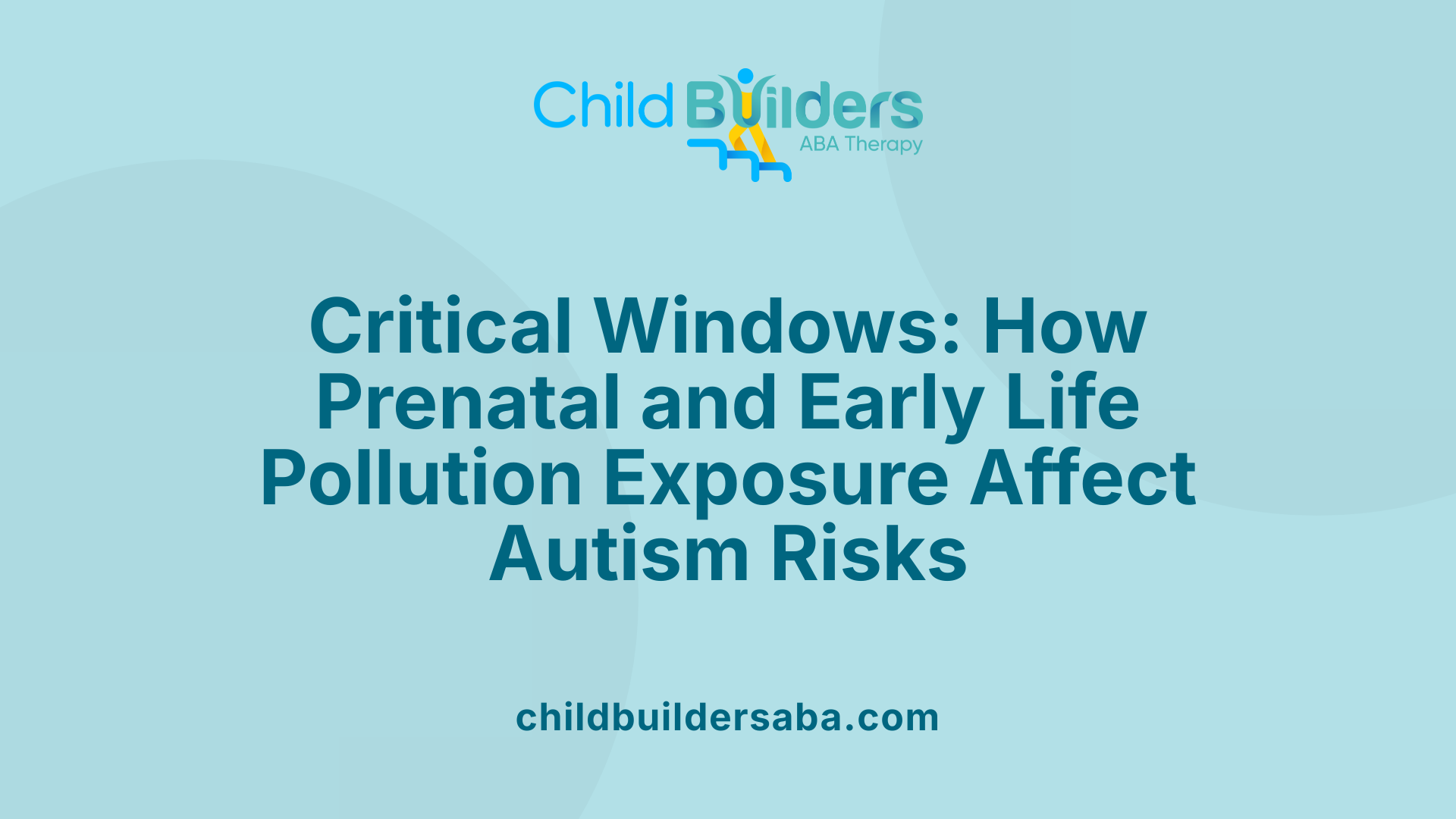
Does prenatal exposure to air pollution affect the likelihood of autism?
Research consistently shows that exposure to air pollution during pregnancy can increase the risk of autism spectrum disorder (ASD) in children. Especially during critical developmental windows like the third trimester, pollutants such as fine particulate matter (PM2.5), nitrogen oxides (NO and NO₂), ozone, and various hazardous chemicals have been linked to higher ASD incidence.
Studies utilizing advanced statistical models—including directed acyclic graphs (DAGs)—have pinpointed the third trimester as a particularly vulnerable period. During this time, exposure to pollutants like PM2.5 can increase ASD risk by approximately 31%, with some research showing odds ratios as high as 1.3 to 2.4 per interquartile range increase.
Particulate matter can cross the placental barrier, reaching the fetal brain, where it may cause neuroinflammation, oxidative stress, and disrupt neurotransmitter systems vital for brain development. Nitrogen oxides and ozone involved in traffic and industrial emissions also interfere with processes like neuronal migration and myelination.
Mechanisms such as neuroinflammation, epigenetic modifications, and endocrine disruption are believed to mediate these effects. For example, pollutants can activate immune pathways like NF-κB, leading to chronic inflammation in the developing brain—a hallmark in ASD.
Large cohort studies in various countries, including Sweden, the Netherlands, and China, support these findings. These investigations highlight that even low levels of pollution, below current regulatory thresholds, may pose risks to fetal neurodevelopment.
In summary, prenatal exposure to air pollution is associated with an increased likelihood of autism, especially with exposure during late pregnancy. This underscores the importance of minimizing pollutant exposure during critical windows of fetal development to help reduce the risk of ASD.
Mechanisms Connecting Air Pollution to Autism
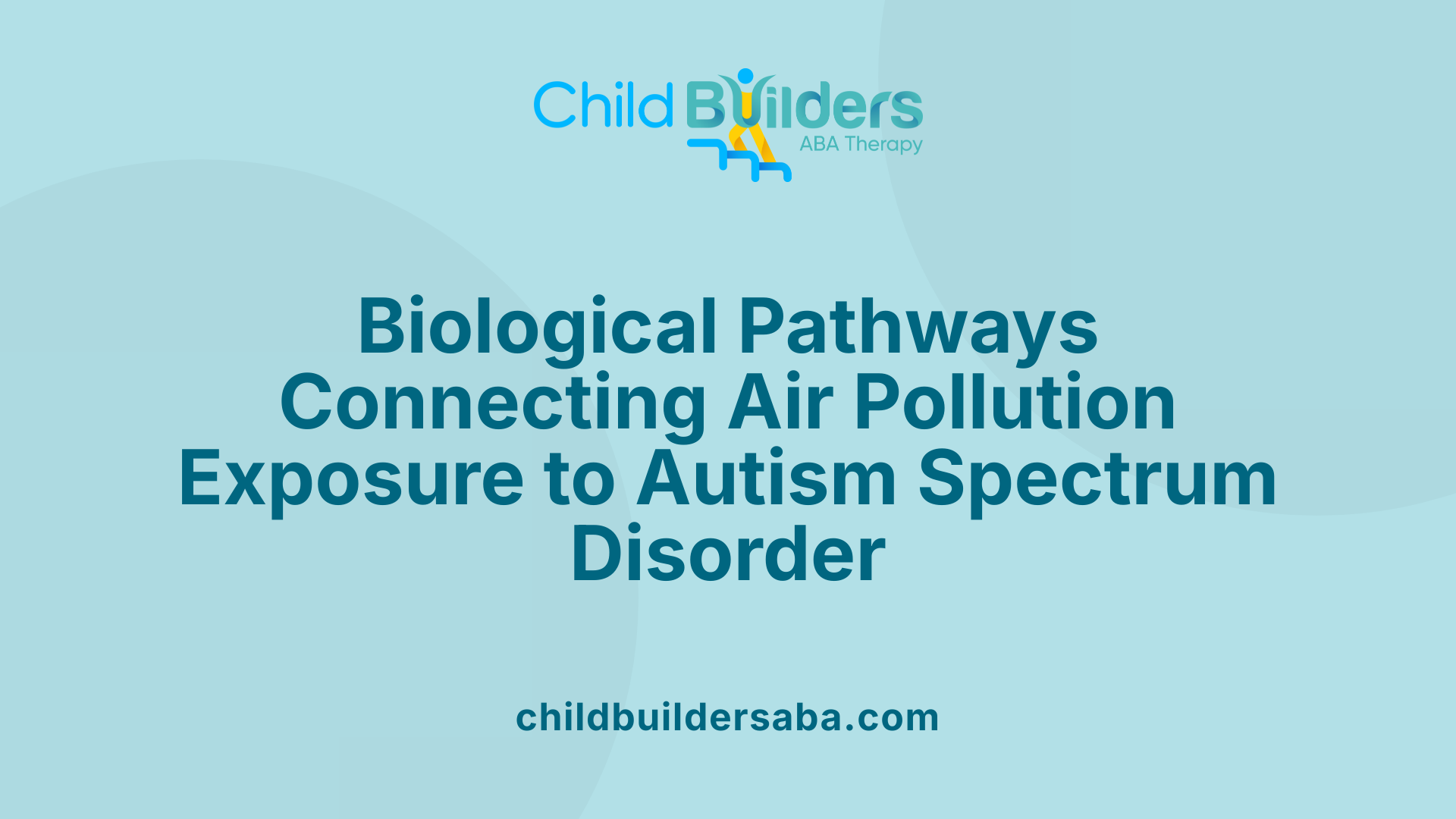
What mechanisms link air pollution to autism spectrum disorder?
Research indicates that exposure to air pollution, especially fine particulate matter (PM2.5), can significantly influence neurodevelopmental outcomes, including the risk of autism spectrum disorder (ASD). The biological pathways involved are complex and multifaceted.
One primary mechanism is neuroinflammation. When pollutants such as nitrogen oxides, ozone, and metals (like copper and PCBs) enter the body, they can activate immune responses in the brain, leading to chronic inflammation. This neuroinflammatory response is believed to interfere with the delicate processes of brain development, particularly during critical windows such as late pregnancy and early childhood.
Oxidative stress also plays a vital role. Pollutants generate reactive oxygen species (ROS), causing damage to neural cells and disrupting normal cellular functions. This oxidative damage can impair neural migration, synaptogenesis, and other key neurodevelopmental processes.
Epigenetic modifications, including changes in DNA methylation and histone structure, are another pathway. Air pollution exposure can alter gene expression without changing the DNA sequence itself, potentially affecting genes involved in brain growth, immune regulation, and neurotransmitter systems.
Furthermore, pollutants such as nitrogen dioxide and volatile organic compounds act as endocrine disruptors, interfering with hormones like estrogen and thyroid hormones crucial for brain development. Disruption of these hormonal pathways can impair normal neurodevelopment and increase vulnerability to ASD.
The combined effects of inflammation, oxidative stress, epigenetic alterations, and endocrine disruption provide a biologically plausible explanation for how air pollution influences ASD development, especially when exposure occurs during sensitive developmental stages.
Epidemiology and Meta-Analyses on Pollution and ASD
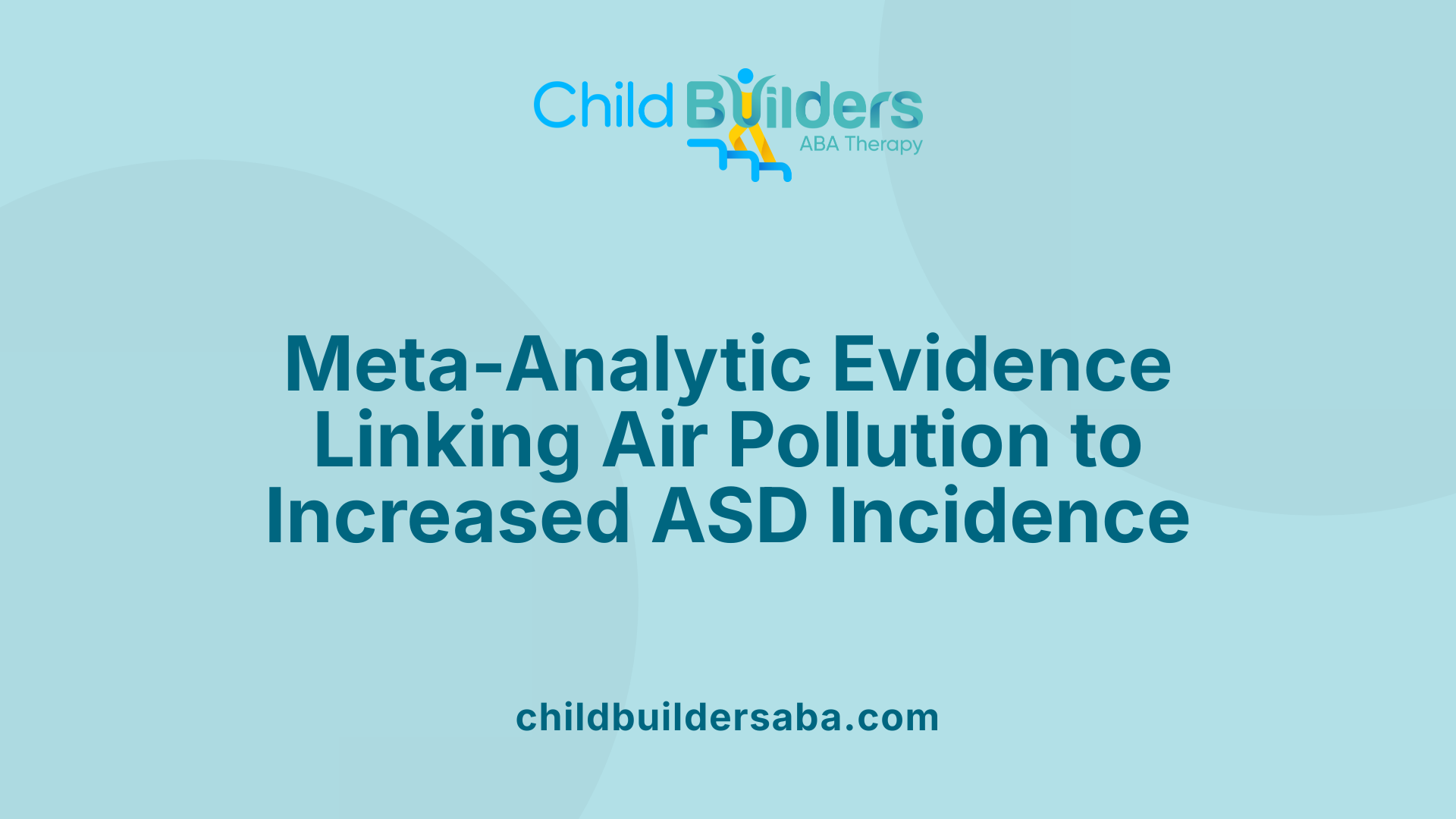 Recent research Strongly indicates a link between air pollution and autism spectrum disorder (ASD), especially during key developmental periods such as pregnancy and early childhood. Multiple studies and meta-analyses reveal that exposure to pollutants like fine particulate matter (PM2.5), nitrogen dioxide (NO₂), ground-level ozone (O₃), and sulfur dioxide (SO₂) can adversely affect neurodevelopment.
Recent research Strongly indicates a link between air pollution and autism spectrum disorder (ASD), especially during key developmental periods such as pregnancy and early childhood. Multiple studies and meta-analyses reveal that exposure to pollutants like fine particulate matter (PM2.5), nitrogen dioxide (NO₂), ground-level ozone (O₃), and sulfur dioxide (SO₂) can adversely affect neurodevelopment.
Researchers have observed that exposure during the third trimester of pregnancy and the first years of life is associated with increased ASD risk. For example, a 2021 meta-analysis published in Environmental Research Letters found that prenatal exposure to PM2.5 increased ASD risk by about 31%, with the highest risk during the third trimester. Similarly, early childhood exposure was linked to a 64% increased risk at a level of just 10 micrograms per cubic meter.
Many studies have examined pollutant sources, such as traffic emissions, industrial factories, and residential wood burning. These sources emit fine particles and nitrogen oxides that can cross the placental barrier and reach the fetal brain, potentially disrupting neural development.
Research tools like high-resolution modeling and advanced statistical methods help clarify the timing and sources of risk. For example, exposure to specific pollutants during pregnancy has been associated with neuroinflammation, oxidative stress, and epigenetic changes, all of which can interfere with processes like neuronal migration, myelination, and neurotransmitter function.
Table summarizing notable findings:
| Study Type | Pollutants Examined | Critical Exposure Window | Main Outcome | Odds Ratio / Risk Increase |
|---|---|---|---|---|
| Meta-analysis (2021) | PM2.5, NO₂, O₃ | Prenatal (third trimester), Early childhood | ASD risk | 31% increase (prenatal), 64% during early childhood |
| Swedish cohort | PM2.5 sources (wood burning, traffic) | Pregnancy | Childhood autism | OR 1.2–1.3 per IQR increase |
| Chinese study | PM2.5 | Early childhood (first year) | ASD | Up to 78% increased risk |
| US cohort | NO₂, PM2.5 | Prenatal and postnatal | ASD and hospital admissions | ORs around 1.2–1.8 |
Overall, the accumulating evidence suggests that limiting exposure to air pollution during pregnancy and early childhood could help reduce the risk of ASD. While causation has not been definitively established, the biological plausibility and epidemiological consistency strongly support public health efforts to improve air quality, especially for vulnerable populations like pregnant women and young children.
Search term for more information: "epidemiological studies on air pollution and autism".
Biological Mechanisms and Pathways
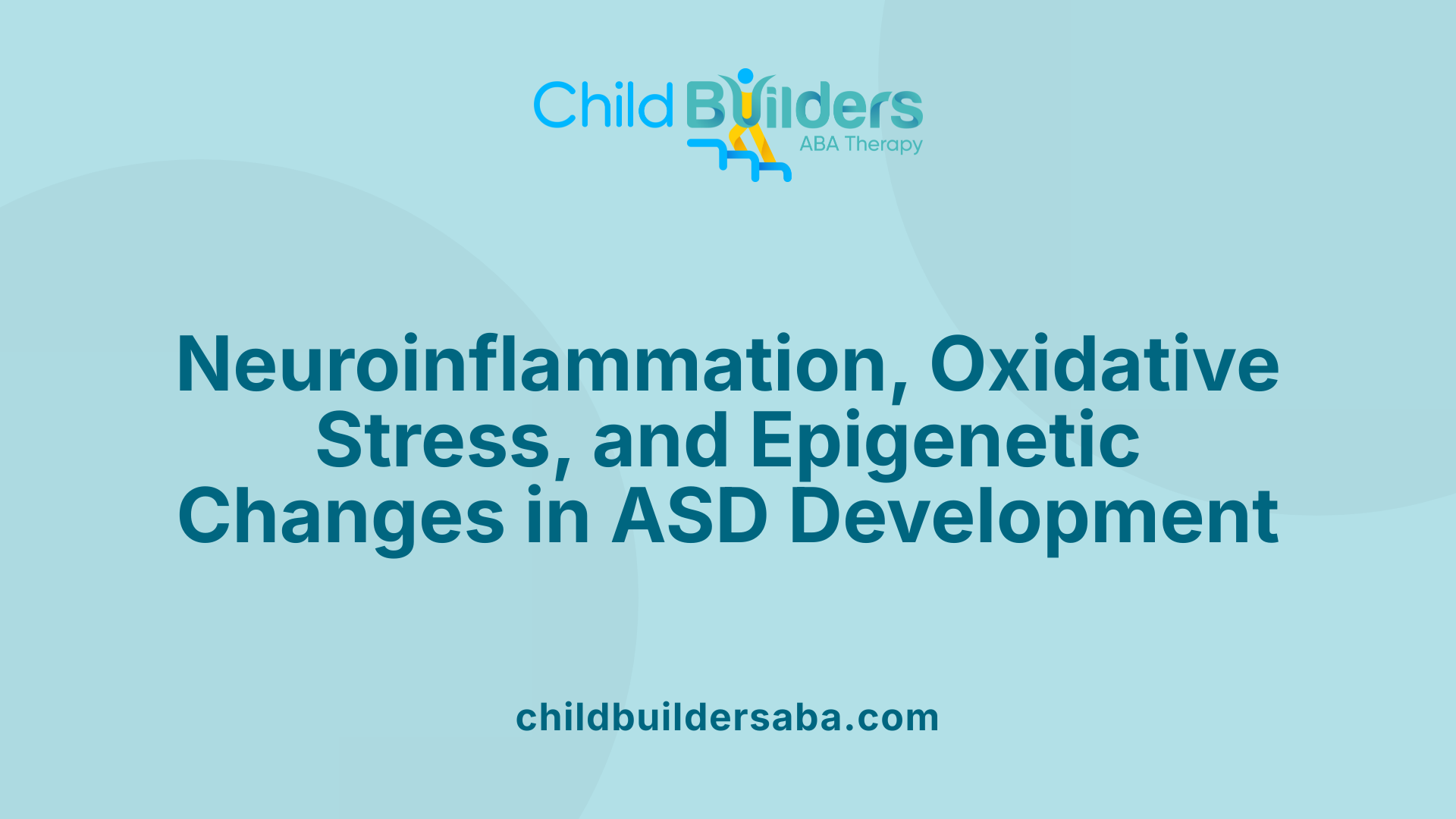
What are the mechanisms linking air pollution to autism spectrum disorder?
Research indicates that exposure to air pollution, especially during critical periods such as prenatal development and early childhood, can affect brain development through multiple biological pathways. These mechanisms provide insight into how environmental pollutants may influence the risk of ASD.
One prominent pathway involves neuroinflammation. When the brain perceives pollutants such as PM2.5 or nitrogen oxides, it can trigger an immune response leading to activation of inflammatory pathways. This neuroinflammation can disrupt normal neural processes and has been linked to neurodevelopmental disorders.
Oxidative stress is another critical mechanism. Fine particles and other pollutants generate reactive oxygen species (ROS), which can damage neuronal cells, impairing brain structure and function. The damage caused by oxidative stress can interfere with neural connectivity and synapse formation.
Disruption of neurotransmitter systems, including glutamate and gamma-aminobutyric acid (GABA), is also observed in response to pollutant exposure. These neurotransmitters are vital for brain communication, learning, and behavior. Imbalances caused by pollutants can alter neural circuitry development, potentially leading to ASD.
Epigenetic modifications, such as DNA methylation and changes to histone proteins, are another pathway through which air pollution impacts neurodevelopment. These modifications can turn genes on or off, affecting genes involved in brain growth, immune response, and neural signaling. Environmental pollutants can induce these epigenetic changes, contributing to ASD susceptibility.
Furthermore, some airborne chemicals act as endocrine disruptors, modifying hormone levels like estrogen and thyroid hormones, which are crucial for brain development. Disrupting hormonal balance during sensitive periods can have long-term effects on cognitive and behavioral outcomes.
Together, these interconnected pathways reinforce the biological plausibility that air pollution exposure during key developmental windows can impair neurodevelopment and increase ASD risk. Ongoing research aims to elucidate these complex mechanisms further, emphasizing the importance of minimizing pollutant exposure during pregnancy and early childhood.
Implications for Public Health and Policy
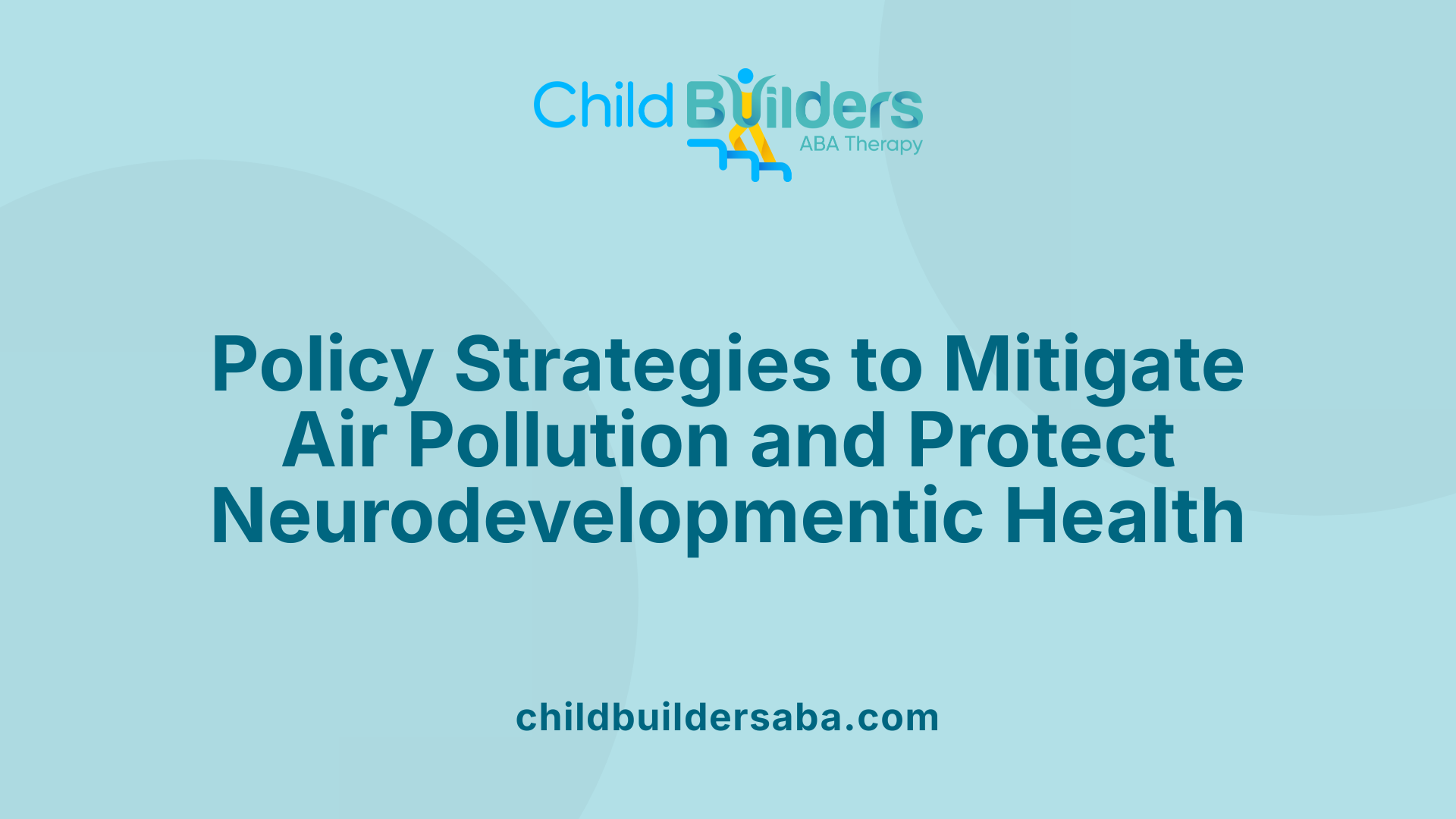 Recent studies highlight a clear link between air pollution exposure and increased autism risk, especially during pregnancy and early childhood. Fine particulate matter (PM2.5), nitrogen dioxide (NO2), ozone (O₃), and sulfur dioxide (SO₂) are pollutants consistently associated with neurodevelopmental disturbances.
Recent studies highlight a clear link between air pollution exposure and increased autism risk, especially during pregnancy and early childhood. Fine particulate matter (PM2.5), nitrogen dioxide (NO2), ozone (O₃), and sulfur dioxide (SO₂) are pollutants consistently associated with neurodevelopmental disturbances.
Research shows that exposure during crucial periods—like the third trimester of pregnancy and the first years of life—can interfere with brain growth. Biological mechanisms include triggering neuroinflammation, oxidative stress, and epigenetic changes, all of which can affect neuronal migration, myelination, and neurotransmitter systems.
The evidence points toward the importance of minimizing exposure to these pollutants, particularly for expectant mothers and young children. Strategies such as reducing traffic emissions, limiting residential wood burning, and implementing stricter air quality standards can help mitigate risk.
Policy recommendations focus on stricter regulation of pollutants, promotion of cleaner energy sources, and public awareness campaigns. Ensuring air quality standards are not just met but improved to protect vulnerable populations is vital.
| Action Area | Recommendations | Potential Impact |
|---|---|---|
| Regulation | Tighten emission standards for vehicles and industry | Reduce ambient PM2.5 and NO₂ levels |
| Public Awareness | Educate on avoiding high pollution days, especially during pregnancy | Minimize personal exposure |
| Urban Planning | Develop green spaces and promote cleaner transportation | Lower pollution hotspots |
| Research & Monitoring | Support ongoing studies and real-time air quality monitoring | Better data for policy adjustment |
Efforts to lower air pollution levels are essential for protecting neurodevelopment and improving overall public health. As evidence continues to grow, policymakers are encouraged to integrate air quality improvements into health guidelines aimed at reducing ASD risks.
Navigating the Path Forward
The collective evidence from epidemiological, mechanistic, and exposure studies strongly supports the role of air pollution as a modifiable environmental risk factor for autism spectrum disorder. Given the vulnerability of fetuses and young children during critical developmental windows, there is an urgent need for public health strategies that focus on reducing pollution exposure through stricter regulations, urban planning, and individual precautions. Future research should continue to elucidate specific biological pathways, optimal intervention timing, and the combined influence of genetic predispositions. Addressing air pollution is not only crucial for respiratory health but also for promoting healthier neurodevelopment, potentially decreasing the prevalence of ASD and improving long-term outcomes for children worldwide.
References
- Air pollution linked with increased risk of autism in children
- Air Pollution and Autism Spectrum Disorders: Causal or Confounded?
- Exposure to local, source-specific ambient air pollution during ...
- Study highlights air pollution as key environmental factor in autism risk
- Early-Life Exposure to Environmental Air Pollution and Autism ...
- Environmental pollutants as risk factors for autism spectrum disorders
- In utero exposure to near-roadway air pollution and autism spectrum ...





































































































